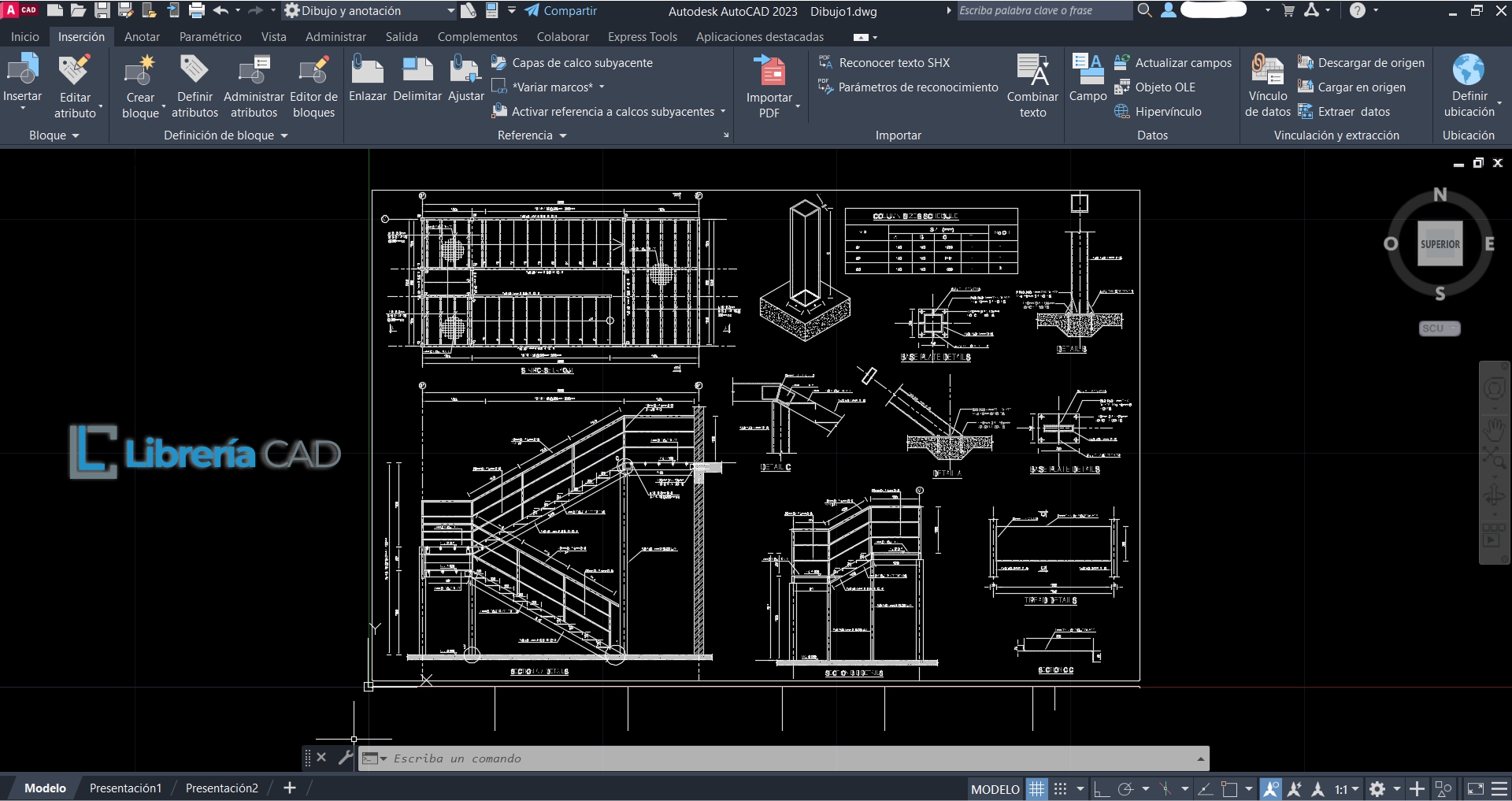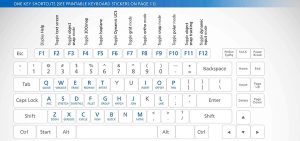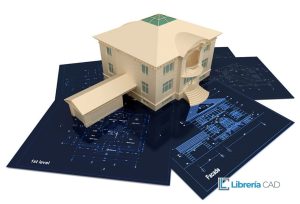
AutoCAD is computer-aided design (CAD) software used to create and edit 2D and 3D drawings. One of the most useful features of AutoCAD is the ability to import PDF files. This allows users to import PDF data into their AutoCAD drawings, which can be useful for a variety of purposes, such as:
- Import architectural or engineering plans
- Import manufacturing drawings
- Import images or graphics
In this article, we will show you how to import a PDF file into AutoCAD.
Table of Contents
Requirements
To import a PDF file into AutoCAD, you will need the following requirements:
- A computer with AutoCAD installed
- A PDF file that you want to import
Steps to follow to Import a PDF file into AutoCAD
To import a PDF file into AutoCAD, follow these steps:
- Open AutoCAD.
- On the ribbon, click the tab Insert.

- In the dialog box Import, Click the button Browse and select the PDF file you want to import.

Import PDF Dialog Box Options
The dialog box Import PDF you have the following options:
Browse
Displays the Browse dialog box (a standard file selection dialog box), where you can select a different PDF file to import.
Page to be imported
When importing a PDF file, you choose the page by entering the page number or clicking the thumbnail image. If you want a larger view of the selected page, you can switch between the full size view and the thumbnail view. Only one page can be imported at a time.
Page size
Displays a standard page size, in imperial or metric units. If the page is non-standard, dimensions are displayed in inches or millimeters, depending on the setting of the MEASUREMENT system variable.
PDF scale
Shows the scale of the PDF file. Metric units are expressed in millimeters; Imperial units are expressed in inches.
Location
Specifies the location of the imported PDF file relative to the location of the current SCP.
Specify the on-screen insertion point
When this option is selected, the location can be specified using the input device or by entering coordinates relative to the current UCS once the dialog box is closed. When this option is disabled, the PDF file is imported into the SCP source (0,0).
Scale factor
You can specify another import scaling factor for imported objects. Importing a page from a PDF file does not use the INSUNITS system variable setting, since each page can be at a different scale.
Rotation
Provides a list of standard rotations. You can also indicate a custom rotation.
PDF data to be imported
You can include or exclude data by type.
Vector geometry
PDF geometric data types are linear paths, Bezier curves, and solid fill areas, which are imported as polylines and 2D solids or solid fill hatches. Within a tolerance, curves that are similar to arcs, circles, and ellipses are interpolated as such. Pattern hatches are imported as multiple independent objects.
TrueType Text
Imports text objects that use TrueType fonts. PDF files only recognize TrueType text objects; Text objects that use SHX fonts are treated as geometric objects. TrueType fonts are matched or replaced by similar fonts available on the system. The imported text is mapped to an AutoCAD text style that begins with the characters PDF_ and the TrueType font name. You can assign a different font to the PDF style with the STYLE command.
raster images
Import raster images by saving them as PNG files and linking them to the current drawing. The path to each raster image is controlled by the PDFIMPORTIMAGEPATH system variable.
Layers
You can choose which method to apply to assign imported objects to layers.
Use PDF layers
Creates AutoCAD layers from the layers stored in the PDF file and applies them to imported objects. Layer names have a PDF prefix. If there are no layers in the PDF file, object layers are created instead.
Create object layers
Creates AutoCAD layers for each of the following general types of objects imported from the PDF file: PDF_Geometry, PDF_Solid Fills, PDF_Images, and PDF_Text.
Current layer
Imports all specified PDF objects to the current layer.
Import options
Various options are available to control how objects are processed after they are imported.
Import as block
Import the PDF file as a block instead of as separate objects.
Join line and arc segments
Join adjacent segments into a polyline, whenever possible.
Tips
- If the PDF you want to import contains text, be sure to select the option TrueType in the dialog Import PDF. This will ensure that the text is imported correctly.
- If the PDF you want to import contains images, be sure to select the option Images in the dialog Import PDF. This will ensure that the images are imported correctly.
- If you want to import only part of the PDF, you can use the tool Polygon to select the part you want to import.
Command to Import PDF files in AutoCAD

Imports geometry, fills, raster images, and TrueType text objects from a specified PDF file.

If you enter the command PDFIMPORT At the command prompt, you are given the options to select a PDF underlay or specify a file.
- If you click the PDF Import option on the Insert tab of the ribbon, the File option is used. You can also specify a PDF file with the IMPORT command.
- If you first select a linked PDF underlay, the PDF Underlay contextual tab appears and you can click Import as Objects.
The following prompts are displayed, and then the Import PDF dialog box opens.
Archive
Opens a standard file selection dialog box, where you can specify the PDF file to import.
Note: Importing a page from a PDF file does not use the INSUNITS system variable setting.
Select PDF Underlay
Imports all or part of a linked PDF underlay as AutoCAD objects. The following options are displayed.
Specify first corner; Specify opposite corner
Requests the diagonal corners of a crossing area rectangular. Objects that cross the specified area are imported.
Polygonal
Request a crossing area polygonal defined by at least three points to specify the objects to import.
All
Selects all objects included in the selected PDF underlay for import.
Parameters
Opens the PDF Import Settings dialog box.
Keep, unlink, or download PDF underlay?
Determines what to do with the selected PDF underlay after importing the specified objects. The Keep option leaves the PDF underlay unchanged, the Unlink option removes the PDF underlay, and the Download option temporarily hides the linked PDF.
How to import PDF files containing layers
PDF files can contain layers, which allow you to organize PDF data into logical groups. When you import a PDF file that contains layers, you can choose whether to import all the layers or just some of them.
To import a PDF file that contains layers, follow these steps:
- Open AutoCAD.
- On the ribbon, click the tab Insert.
- In the group External references, Click the button Import.
- In the dialog box Import, Click the button Browse and select the PDF file you want to import.
- Click the button Open.
- In the dialog box Import PDF, select the option Layers in the section Data to import.
- If you want to import only some layers, click the button Show layers and select the layers you want to import.
- Click the button Accept.
The imported data will be displayed in your AutoCAD drawing, organized in layers.
How to edit imported data from a PDF file
Once you've imported data from a PDF file, you can edit it like any other AutoCAD object. You can use AutoCAD drawing, editing, and annotation tools to modify imported data.
To edit imported data from a PDF file, follow these steps:
- Select the data you want to edit.
- Use AutoCAD drawing, editing, and annotation tools to modify selected data.
For example, you can use the tool MOVER To move the imported data, the tool Rotate to rotate the imported data, or the tool scale to size the imported data.
You can also use AutoCAD's layer tools to organize imported data into layers.
Import data from a PDF file
- Click Insert tab
 Import group
Import group PDF import.
PDF import. 
- In the Select PDF File dialog box, specify the PDF file you want to import and click Open.
- In the Import PDF dialog:
- If the PDF file has multiple pages, select the page you want to import by clicking a thumbnail image or entering a page number.
- Enable or disable the Specify on-screen insertion point option as necessary.
Note: When this option is disabled, the PDF file is imported into the SCP source (0,0). - Set the scale and orientation.
- Set options for importing geometry, fills, raster images, and TrueType text objects.
- Choose the method to apply to assign imported objects to layers.
- Set options to control how objects are processed after they are imported.
- Click OK.
- Specify the insertion point if prompted.
About importing PDF files into AutoCAD
Geometry, fills, raster images, and TrueType text can be imported from a PDF file into the current drawing. Visual fidelity, along with some properties such as PDF scale, layers, line weights, and colors can be preserved.
PDF files are a popular way to publish and share design data for review and markup. AutoCAD allows you to create PDF files as a publishing form for AutoCAD drawings and import PDF data into AutoCAD using one of two options:
- PDF files can be linked to drawings as underlays, which can serve as a reference when collaborating on projects.
- PDF data can be imported as objects, in part or in whole. These objects can be used as a reference and can also be modified.
If you import data in PDF format, you can specify a page of a PDF file or convert all or part of a linked PDF underlay into AutoCAD objects.



